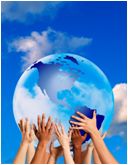Kids, Teens and the Environment:
Pollution Prevention and Environmental Health Information For Parents and Caregivers

Kids and Consumerism - Kids and teens are bombarded with messages to buy the "latest and greatest." New American Dream has tools for parenting in a consumer culture
Topics
- Anti-bacterial Products and Hand Sanitizers, Nail Polish, Sunscreen, Make-up and Body Products, Additional Resources
Children's Environmental Health Resources
| At Home | ||
| Cleaning products |
Cleaning products can contain solvents and surfactants that may present a health hazard to children. These products can impact air quality and trigger asthma. You can purchase less toxic cleaning products or you can follow our "recipes " to make them yourself with simple ingredients. (Also available in Spanish .)
|
|
| Food |
Conventionally grown fruits and vegetables can contain pesticide residue. Farmed fish, meat, poultry and dairy items can contain antibiotics and chemicals like chlorine. These substances pollute the environment and can affect your kid's health.
|
|
| Toys |
|
|
| Furniture , Carpeting and Paint |
Some furniture, carpeting and home accessories may contain chemicals such as formaldehyde that can make kids sick. There are many alternatives now available. If you are redecorating a child's room or preparing a room for a new baby, you may want to use environmentally-friendly products.
|
|
| Yard |
|
|
| At School | ||
| School Lunches |
|
|
| Walking And Biking To School |
Walking and biking can reduce traffic congestion and contribute to a healthy life style, improve and air quality and more livable communities.
|
|
| Anti-Idling |
Idling is Fuelish! Turn off your engine while you wait to pick up your kids from school.
|
|
| Healthy Schools | Learn how your community can create healthy schools inside and out with less impact on the environment. | |
| Get Rewarded |
Get your kid's class to take on an environmental project and get recognized for your efforts! The CT Green Leaf Schools program recognizes the accomplishments of students and schools.
|
|
| Personal Care Products | |||
| Anti-bacterial Products and Hand Sanitizers |
Does your kid carry hand sanitizer around in her back pack? Many hand-sanitizer products contain triclosan . EPA's Office of Research and Development (ORD) is updating their 2008 assessment of the potential endocrine effects of triclosan. Triclosan may also bioaccumulate in aquatic organisms.
|
||
| Nail Polish |
Nail polish may contain formaldehyde, toluene and dibutyl phthalate (DBP), a plasticizer. Toluene pollutes water; formaldehyde is a known carcinogen; and DBP is a hormone disrupter. If your teen insists on painted nails, choose safer nail polishes and removers.
|
||
| Sunscreen |
Do you know what's in that sunscreen you are slathering on your children? Chemicals in sunscreen can contain suspected carcinogens and endocrine disrupters and pollute our environment. Learn what to look for and what to avoid when buying sunscreen.
|
||
| Make-up and Body Products |
Experimenting with make-up and hair and body products is just something that most teenagers do. So, educate them to make smarter choices for their health and the environment.
|
||
| Additional Resources |
|
||
| Kids And The Great Outdoors | |
| Kids are distracted so much with computers, TVs, phones and other electronic gadgets that they may have lost touch with the outdoors. There is also an epidemic of childhood obesity. Getting them outside in activities that appeal to them will give them an appreciation of natural world and help to keep them healthy. |  |
|
|
| Kids And Caring For the Earth | |
 |
Even young children can get involved in caring for the earth. Maybe it can be their job to remember to bring reusable shopping bags to the store. Older children can be in charge of the recycling bin at home. High school students can take on environmental projects at school or in the community. Here are some ideas on how you can encourage your kids to be environmental stewards. |
|
|
| Children’s Environmental Health Resources |
|

